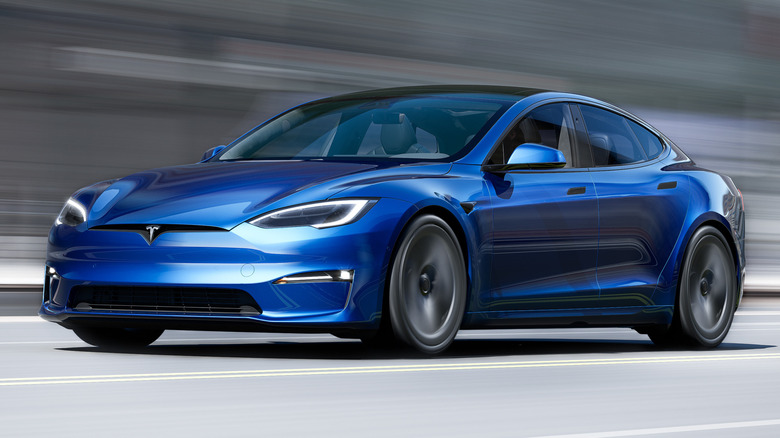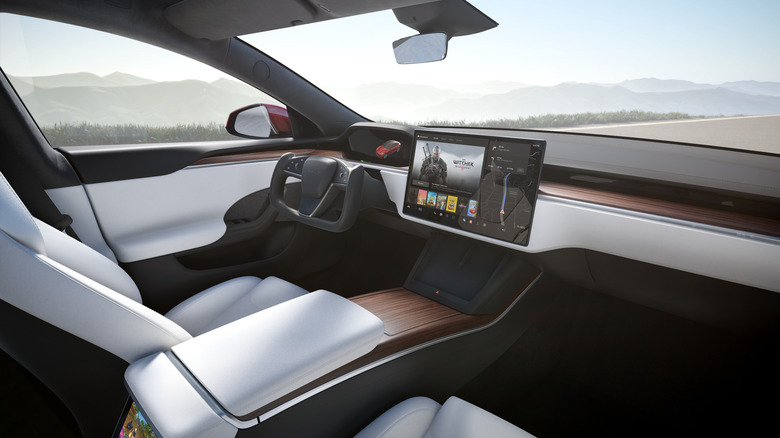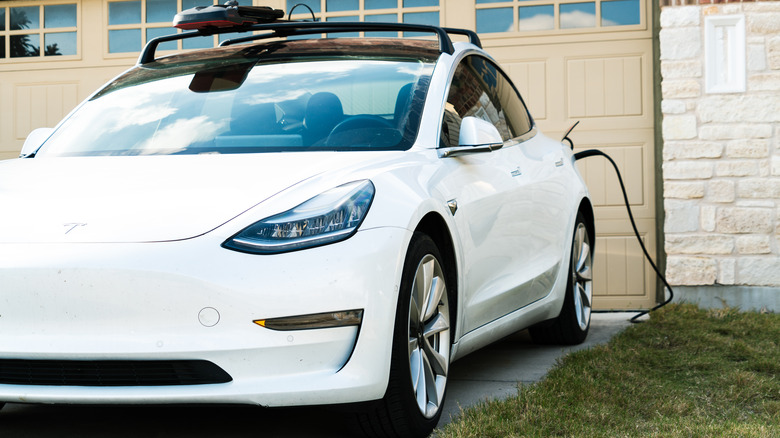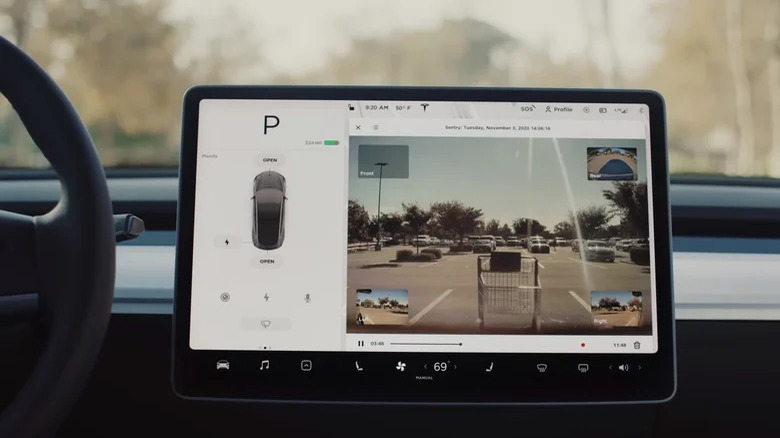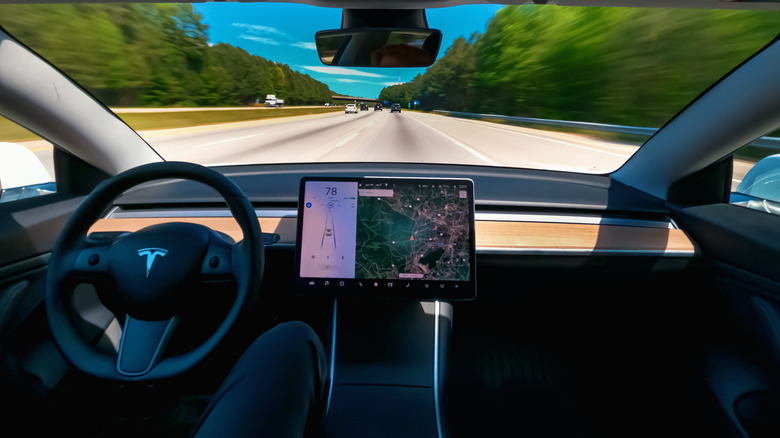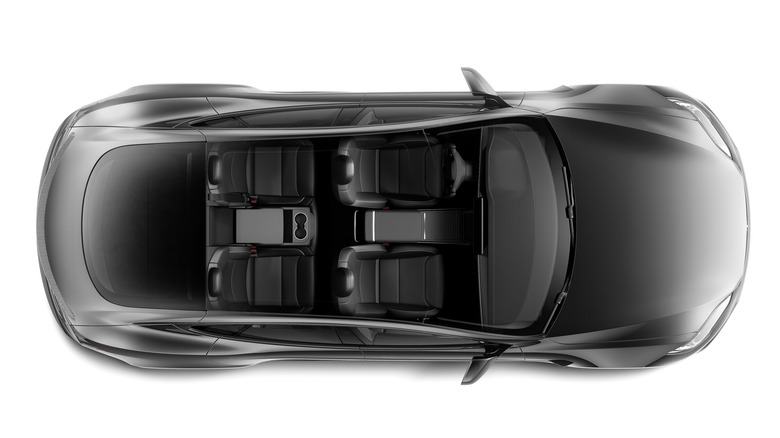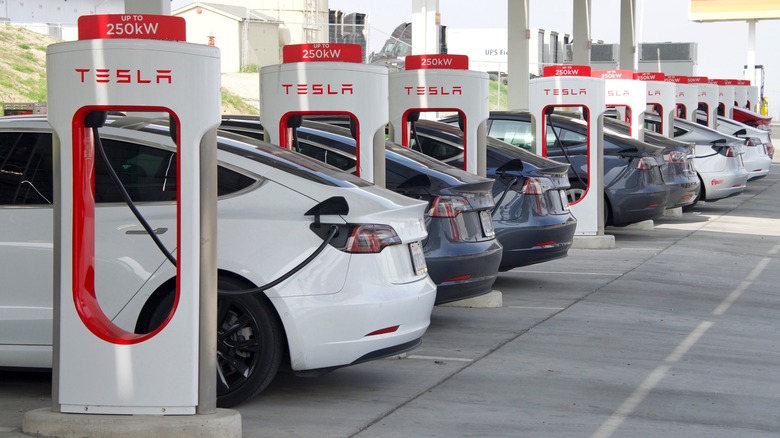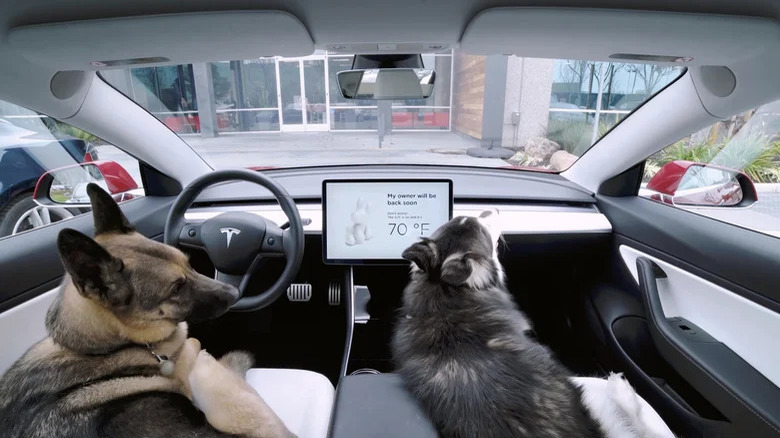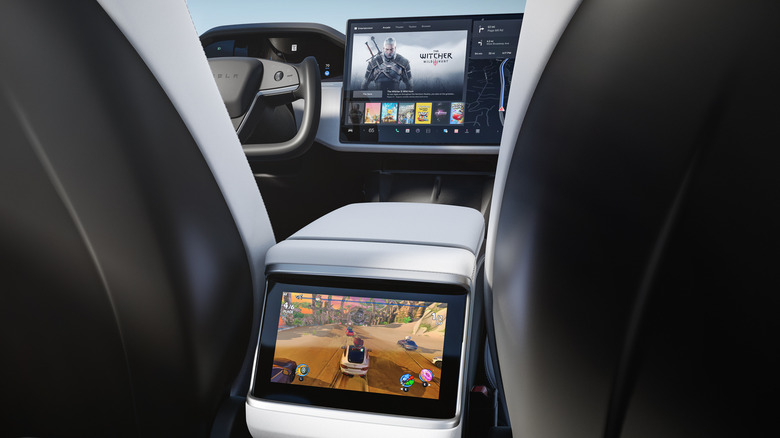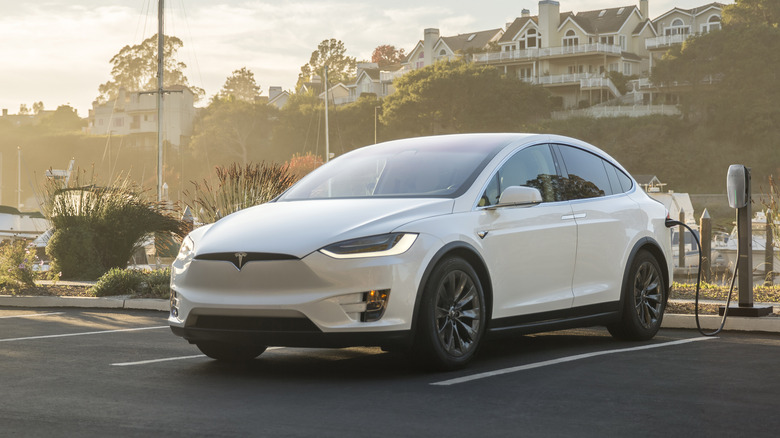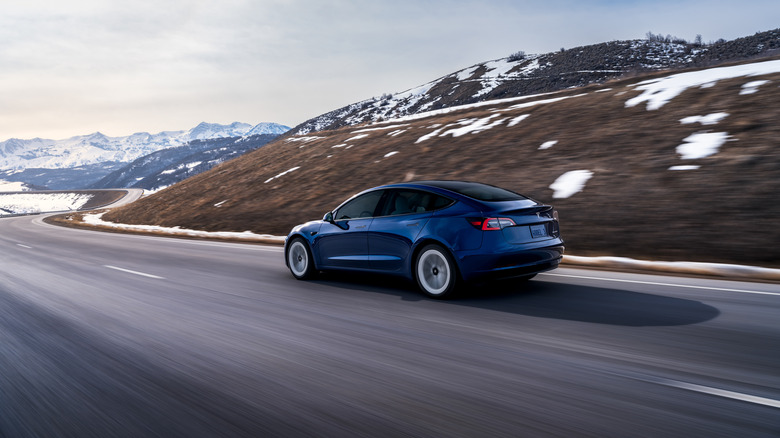10 Of Tesla's Coolest Electric Vehicle Innovations
In just a couple of decades, Tesla has undergone a transformation from a plucky startup with big ambitions into one of the most important automakers in the industry. A big part of that success has been down to the many innovations that Elon Musk and his team have developed over the years, with some of Tesla's most influential ideas being later copied by rival EV makers. These innovations haven't been without their flaws — there have been more than a few recalls and broken promises along the way — but nonetheless, the marque's continuing desire to push the envelope has no doubt been a driving factor in helping its popularity explode.
Many of Tesla's best innovations are shared across every vehicle in its range, giving owners a chance to experience them no matter what model they drive. From powertrain advances to cutting-edge entertainment, Tesla's reputation as one of the most innovative automakers in the industry is hard-won. Here are 10 of the brand's best ideas so far.
Minimalist interior
Removing traditional buttons and switches in favor of centralizing controls through a touchscreen isn't a feature unique to Tesla today, but it was Tesla who originally popularized the idea. The touchscreen-centric design ethos has several key advantages. For starters, it allows new features to be deployed remotely without the need for additional buttons or switches. This means new features can be continually added over time, allowing Teslas to remain cutting-edge for longer than was previously possible with a traditionally-designed car.
It also gives each car's interior a futuristic, minimalist look, one which has been copied by plenty of manufacturers both in the EV space and in gas-powered cars. Moving all the controls onto the touchscreen presents some hazards, with the potential for the driver to become distracted from the road if they're trying to navigate through several layers of menus to adjust the thing they want. Rival carmakers like Hyundai have gone as far as saying they'll keep buttons in all their cars as they deem touchscreen controls too dangerous. However, those concerns haven't cut off Tesla buyers, and the overall idea of keeping the cabin as minimalist as possible has proven to be very popular, to the point that other carmakers are now adopting the idea across much of their ranges.
Over-the-air software updates
Another Tesla innovation that's now made its way into lots of rival cars is over-the-air update functionality, which lets the automaker add new features, fix bugs, or overhaul existing software without the need to visit a service center. Tesla wasn't the first manufacturer to use over-the-air updates, but earlier implementations of the system were much more limited in scope, being used only for things like updating navigation maps. The system used by Tesla can update almost any part of the car's software, and the brand proved just how useful this innovation could be when it was forced to recall its Full Self-Driving beta over safety concerns in early 2023. Rather than require owners to book an appointment at a dealer or garage, the company simply disabled the feature through a software update.
Other automakers quickly caught on to the potential benefits of the system, with Ford beginning an over-the-air rollout in 2020, and VW and Kia more recently launching their own over-the-air software updates. Although it has remained the leading pioneer of OTA updates, Tesla has faced several legal challenges against them. This includes a recent filing that, according to Reuters, alleges that a group of Model S and Model X owners saw range reductions of up to 20% after an update was installed. The system is not without its flaws, then, but using over-the-air updates has proven to be a net positive for the majority of Tesla owners.
Sentry Mode
Theft, vandalism, or bumps and scrapes are all part of the inherent risks that come with using a car every day, but Tesla's Sentry Mode aims to mitigate those risks with cameras that are always recording. When the mode is activated, the car constantly monitors its surroundings, and the system will send an alert to the driver if it detects anything suspicious. In addition, the car can flash its lights and warn pedestrians they're being recorded through an external speaker.
This can be useful for a number of reasons. As well as acting as a deterrent for thieves or vandals, it's also useful to prove who's responsible for any minor damages — for example, if a shopping cart rolls into your car, or someone clips it while reversing out of a parking space. Footage captured by the car can be viewed live through the driver's phone and saved, allowing it to be sent to an insurer to prove who's at fault in case you need to make a claim.
Semi-autonomous driving
Tesla's self-driving program has been subject to plenty of controversy over the years, both on the grounds of safety and because of Elon Musk's broken promises to buyers. In fact, it was almost a decade ago that SlashGear first reported on Tesla's self-driving car plan, with Musk claiming at the time that cars with self-driving capability in 90% of situations would be available by 2016. Fast forward another seven years past that initial release window, and Tesla still hasn't reached that goal, although its semi-autonomous system is one of the most advanced on the market.
Although progress has been slower than Musk initially claimed, the Autopilot and Full Self-Driving systems are still an impressive feat of engineering. Few other cars on the market can match Tesla's range of self-driving features, and for many buyers, that's a big selling point. It might be a cool idea to have a car that's capable of taking you wherever you need to go by itself, but the reality is that self-driving functionality remains limited for now. Nonetheless, follow the rules for safe operation and Tesla's semi-autonomous driving modes can be an invaluable tool for longer road trips or the daily commute.
Bioweapon Defense Mode
It might sound like something out of a sci-fi film, but Tesla's Bioweapon Defense Mode actually has a very practical real-world use. Using HEPA filters, the system detects pollutants and pollen in the air, then purifies that air before it's drawn into the cabin. The automaker ran a test on the system in 2016 and said that it was so effective that it could be used to escape an actual bioweapon attack, but thankfully that's a claim that Tesla owners are unlikely to need to put to the test anytime soon.
The feature comes in handy in both urban and rural environments, too — it stops potentially harmful exhaust emissions from other cars entering the cabin if you're stuck in city traffic, but it can also be useful if you suffer from seasonal allergies and regularly drive past fields in the summer. In addition to stopping pollutants and pollen, the system can also filter out bad smells from cow pastures, landfills, fires, or anything else you happen to drive past on your journey.
Supercharger network
Perhaps the biggest single advantage that Tesla owners have over owners of other EVs is access to the Supercharger network, which remains one of the largest charging networks in America. Unlike rival networks, many of the chargers at Tesla charging stations are DC fast chargers, meaning cars can be recharged considerably faster than the competition. For longer journeys, a lack of charging points outside of major cities can be a deal breaker for many drivers and is one of the most often cited reasons why EV adoption remains low outside urban centers.
Tesla's method of installing a nationwide network of fast charging points has proved to be hugely beneficial, although rival networks are slowly beginning to catch up. Elon Musk has previously talked about opening the Supercharger network up to rival brands, but so far, nothing has come of it, save for a few pilot schemes. Tesla's class-leading ranges, combined with readily available fast charging points, have proved to be a winning formula for Musk so far, so it seems unlikely that he'll be too keen to give up on that advantage anytime soon.
Dog Mode
While any dog owner should be well aware that leaving a dog in a car on a hot day is potentially very dangerous, a minority continue doing so anyway. Tesla has provided a solution for this by implementing the Dog Mode feature, which allows the air conditioning to remain on in the car even after the owner locks it and walks away. Owners can set an optimal temperature for their pooch through the central touchscreen, and then while they're away, the screen will show a temperature readout alongside a message to passersby that the dog is safe in the car.
While it's still not advisable to leave your dog in the car for long periods of time, the ability to quickly pop to the shop on the way back from a walk can come in very handy for dog owners. To ensure your pets remain happy and comfortable while you're away, you can keep an eye on them through the live-feed camera, which can be accessed through the Tesla app.
Arcade and video streaming
Waiting around in the car, be that waiting to pick someone up or waiting to charge the car, can be a very boring affair. While many of us resort to our phones by default, Tesla offers a variety of in-car entertainment solutions to help time pass quicker. One of those solutions is Arcade, which offers owners a selection of games to play, which is either controlled through the touchscreen or with the car's steering wheel (or yoke in certain models).
Most of the titles tend towards classic arcade fare, although more recent games like "Fallout Shelter" are also available. Alternatively, drivers can stream content from a variety of platforms, including Netflix, Hulu, and Twitch. If neither of the former options sounds like a good way to pass the time, then there's also Caraoke, which lets drivers and passengers alike sing along to their favorite songs with lyrics displayed on the screen. Those who prefer to sing solo can disable the main vocal with the microphone icon, leaving them to be the star of the show – or not, depending on their vocal talents.
Combining performance and practicality
Leaving aside Tesla's in-car innovations, another key area where the brand has historically excelled is giving owners both performance and practicality in one usable package. Before the Model S launched, the idea of a sporty yet practical battery EV was just that, only really an idea. Competitors like the Smart ForTwo Electric and Honda Fit EV proved that it was possible to get an affordable electric vehicle with enough range to make it a feasible daily driver, assuming you lived in a city. But none of them could venture far out of town, much less at any speed.
Tesla proved that EVs could not only be practical to live with, but also that they could also deliver performance figures that were once reserved for supercars. Not only that, but they could do so at a reasonably attainable price. An EV with limited range and tepid acceleration now seemed like more of an unacceptable compromise in the wake of this new breed of zero-emissions vehicle, forcing other manufacturers to step their game up to remain competitive.
Class-leading range
One of the key anxieties surrounding electric cars is that they might run out of charge before the driver can find a charging station, but that's never been less true for Tesla thanks to a combination of improved infrastructure and the brand's consistently superior range. In recent years, other rivals have caught up with Tesla in some respects, but all of the automaker's current lineup is still either class-leading or very close to being leading in its respective segment.
In 2011, the year before the launch of the Model S, the average range for a new BEV was around 86 miles, but now a top-spec Model S can travel over 400 miles on a charge. Very few drivers are really going to need to drive longer distances without stopping on a regular basis, making EVs just as practical as gas-powered cars in that respect for many people. Tesla has continued to eke higher range figures out of each generation of its vehicles, so it's likely that the next crop of Teslas will boast even longer ranges than the current lineup.
